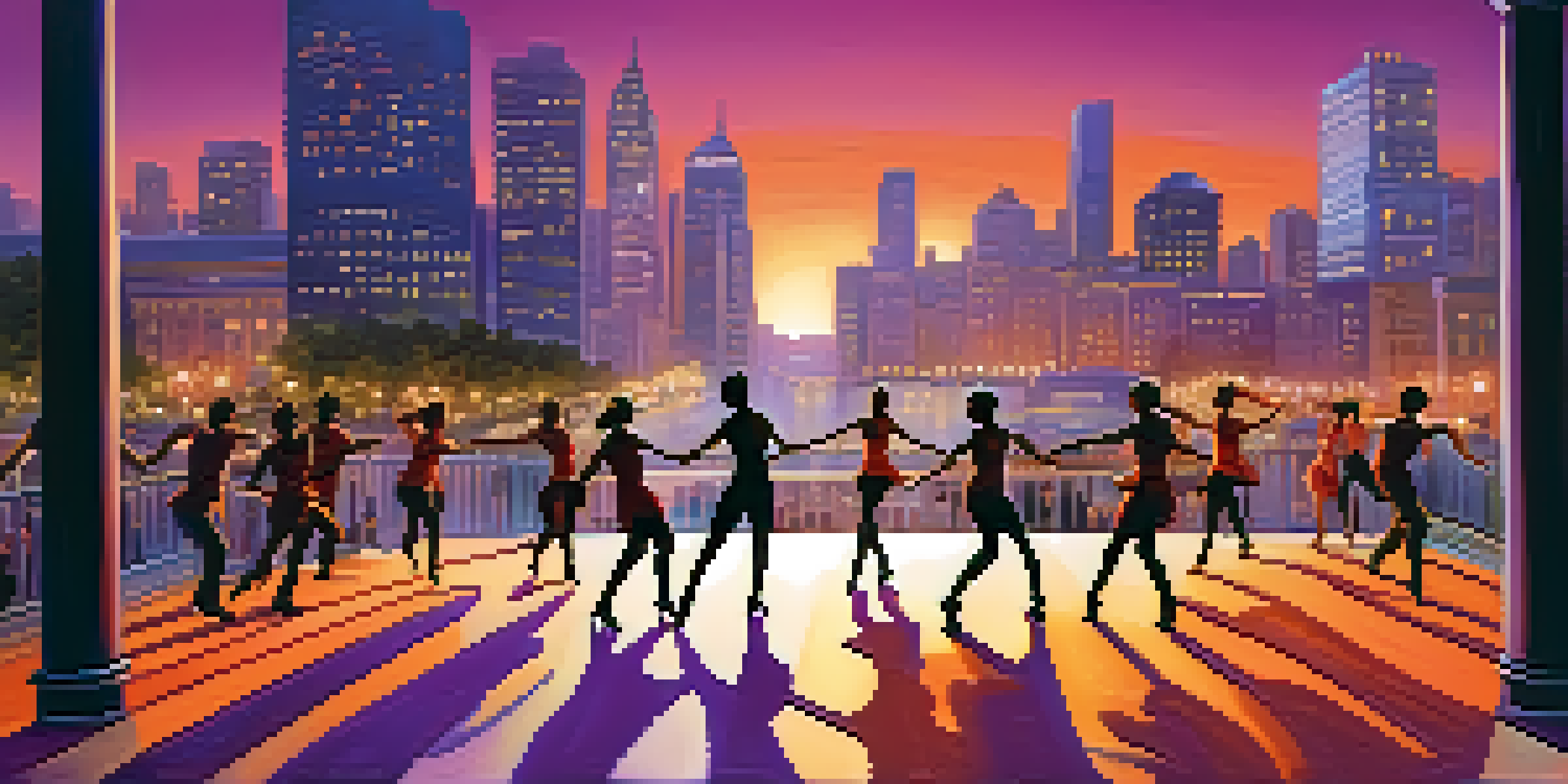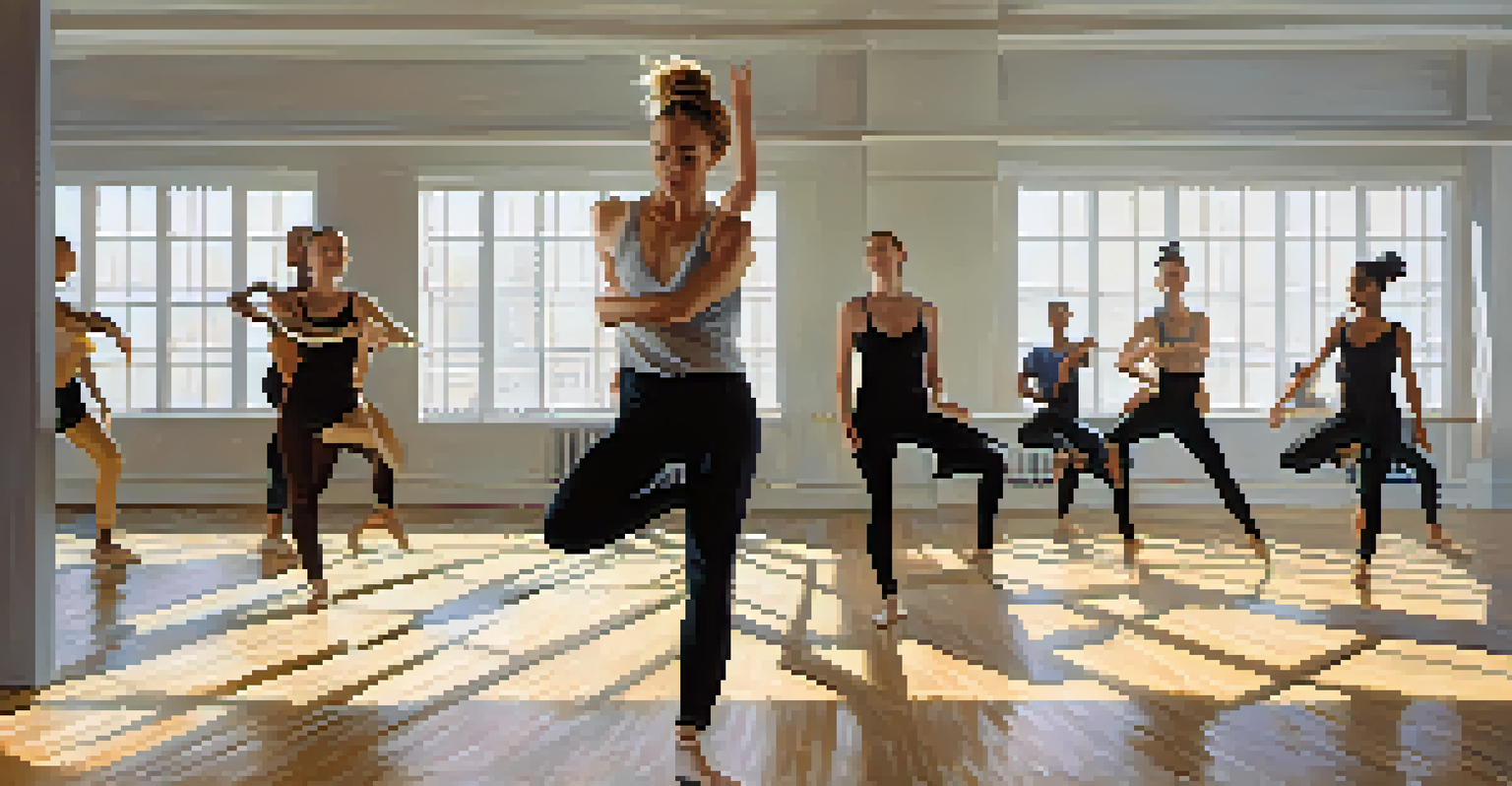Exploring the Evolution of Dance in Contemporary Performance Art

The Roots of Dance in Performance Art
Dance has always been a vital part of performance art, tracing its origins back to ancient rituals and celebrations. In these early forms, movement was a language of its own, communicating stories and emotions without the need for words. Over time, dance evolved, incorporating cultural influences and personal expressions that shaped its various styles.
Dance is the hidden language of the soul.
As we moved into the 20th century, dance began to break away from traditional structures, embracing freedom and innovation. Artists like Martha Graham and Merce Cunningham pushed boundaries, merging dance with theater, music, and visual arts. This fusion created a new landscape in which dance became a medium for exploring complex themes and societal issues.
Today, the roots of dance in performance art remind us of its rich history while paving the way for modern interpretations. This evolution continues to inspire artists to experiment and redefine what dance can be, making it an ever-changing form of expression in contemporary performance.
Influence of Technology on Dance
Technology has dramatically reshaped the landscape of contemporary dance, introducing new tools and platforms that enhance creativity. From digital projections to interactive installations, choreographers are now able to explore dimensions previously unimagined. This intersection of technology and dance allows for unique storytelling methods that captivate audiences in fresh ways.

Moreover, social media has transformed how dance is shared and consumed. Platforms like Instagram and TikTok have given rise to viral dance trends, allowing dancers to reach a global audience instantly. This democratization of dance has enabled diverse voices to emerge, enriching the performance art scene.
Dance's Evolution in Performance Art
Dance has evolved from ancient rituals to a contemporary art form that expresses complex themes and societal issues.
As technology continues to advance, we can expect dance to evolve further, embracing innovations that challenge our perceptions. The marriage of movement with digital elements not only enhances the aesthetic experience but also invites deeper engagement from audiences.
The Role of Cultural Diversity in Dance
Cultural diversity plays a crucial role in the evolution of dance within contemporary performance art. As globalization connects artists from different backgrounds, they bring their unique traditions and styles into the spotlight. This blending of influences creates a rich tapestry of movement that reflects the complexity of our modern world.
Art is the most beautiful of all lies.
For instance, choreographers often incorporate elements of hip-hop, ballet, and traditional folk dances, creating hybrid forms that resonate with broader audiences. This fusion not only celebrates diversity but also fosters a greater understanding and appreciation of various cultural narratives. It allows dancers to share their heritage while also innovating new vocabularies of movement.
Ultimately, embracing cultural diversity enriches the art form, providing a platform for dialogue and collaboration. It encourages artists to push boundaries and explore themes of identity, community, and social justice through their work.
Choreography as a Form of Expression
Choreography in contemporary performance art serves as a potent vehicle for personal and societal expression. Unlike traditional dance, where movements often follow established patterns, contemporary choreography allows for a free-flowing exploration of ideas and emotions. This artistic freedom empowers dancers to express their individual experiences and stories through movement.
Many contemporary choreographers draw from their life experiences, using dance to address issues such as mental health, gender identity, and social justice. For example, the work of artists like Akram Khan and Pina Bausch often tackles heavy themes while remaining deeply personal. Their choreography invites audiences to engage with the narrative on both an emotional and intellectual level.
Technology Transforms Dance Experience
Advancements in technology, including social media and immersive tools, have reshaped how dance is created, shared, and experienced.
As choreography evolves, it continues to challenge conventional notions of performance, encouraging a more inclusive approach to storytelling. This shift highlights the importance of vulnerability and authenticity in dance, making it a powerful tool for connection and understanding.
The Impact of Collaborations in Dance
Collaborations between dancers and artists from various disciplines have transformed the way we perceive contemporary performance art. By merging dance with theater, visual arts, and music, unique experiences emerge that captivate audiences. These collaborations spark creativity and innovation, pushing the boundaries of what dance can achieve.
For example, the partnership between choreographers and visual artists can lead to immersive performances that engage all the senses. The blending of visual elements with movement creates a multi-dimensional experience, inviting viewers to see dance from new perspectives. This collaborative spirit fosters a sense of community and shared creativity among artists.
Ultimately, these partnerships enrich the dance landscape, encouraging experimentation and exploration. The result is a vibrant tapestry of performances that resonate on multiple levels, showcasing the power of collaboration in contemporary art.
The Rise of Dance Festivals and Competitions
In recent years, dance festivals and competitions have gained immense popularity, providing platforms for emerging and established artists to showcase their work. These events celebrate creativity and talent while fostering a sense of community among dancers. They also offer opportunities for networking, learning, and collaboration, enhancing the overall dance ecosystem.
Festivals like the American Dance Festival and Jacob's Pillow Dance Festival highlight diverse styles and innovative choreography, attracting audiences from around the world. These gatherings not only elevate the visibility of dance but also encourage dialogue about its evolving role in society. They serve as a celebration of the art form while also addressing critical conversations about inclusivity and representation.
Cultural Diversity Enriches Dance
The blending of diverse cultural influences in dance fosters greater understanding and innovation within contemporary performance art.
As dance festivals continue to grow, they play a pivotal role in shaping the future of contemporary performance art. They provide a space for experimentation and discovery, allowing artists to push their creative boundaries and inspire one another.
Future Trends in Dance and Performance Art
As we look ahead, several trends are shaping the future of dance in contemporary performance art. One notable trend is the increasing emphasis on interactivity, where audiences are invited to engage with the performance. This shift not only enhances the viewing experience but also transforms the traditional relationship between performer and spectator.
Additionally, the use of virtual reality (VR) and augmented reality (AR) is set to revolutionize how dance is experienced. These technologies offer immersive environments that allow audiences to explore dance in entirely new dimensions, creating unique and personal interactions with the art. This evolution challenges artists to think creatively about how they present their work.

As dance continues to evolve, it will undoubtedly reflect societal changes and emerging technologies. The future of dance in contemporary performance art promises to be vibrant, diverse, and filled with exciting possibilities that invite us all to participate in the journey.